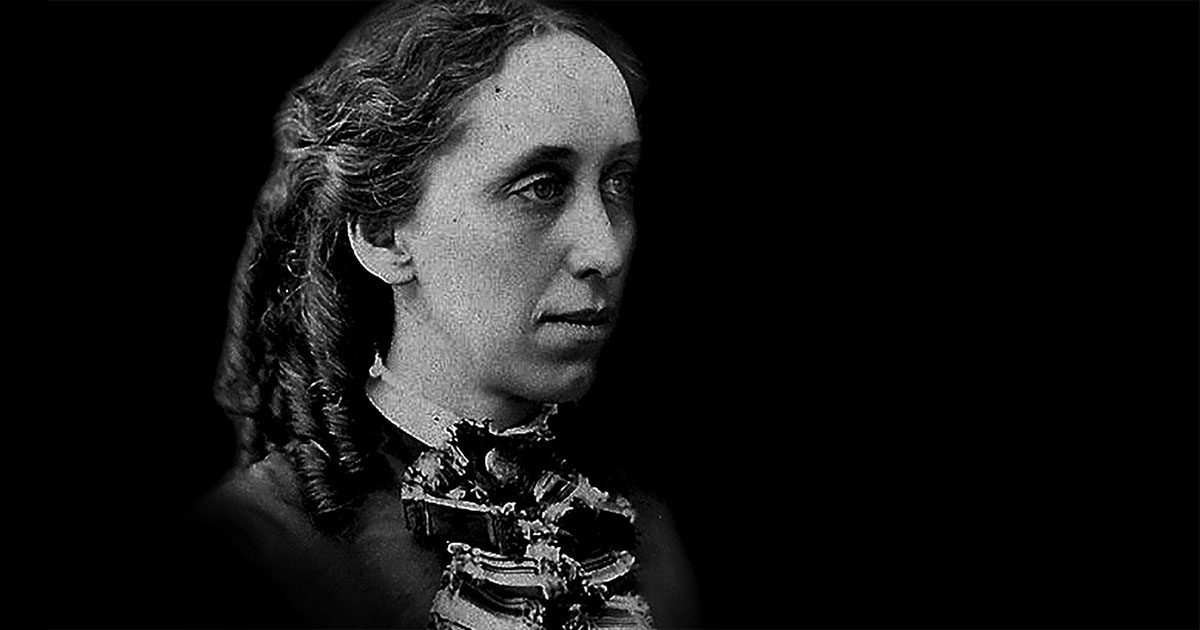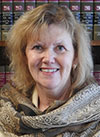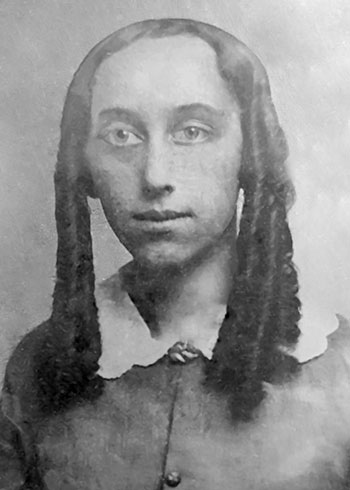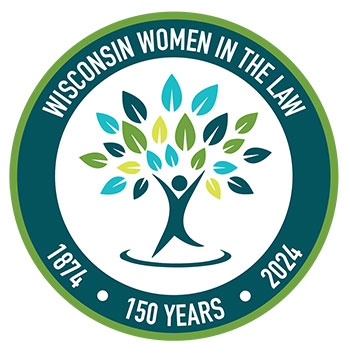
On June 17, 1874, Lavinia Goodell, then a Janesville resident, became the first woman admitted to the bar in Wisconsin. Even those who have heard of Goodell’s accomplishment probably know little else about her. Although her life was short, it was well lived, and she was a person of diverse interests and accomplishments.
Goodell practiced law for less than six years, dying of cancer in 1880 at the age of 40. Although she was somewhat of a national celebrity in her day, if Goodell is remembered at all in 2024 it is likely because of her battle to be admitted to practice before the Wisconsin Supreme Court and Chief Justice Ryan’s condescending 1876 decision denying her admission because allowing women to practice law would be “treason against nature.”1 Goodell promptly asked Assembly Speaker J.B. Cassoday, also a Janesville attorney, to introduce a bill that would prohibit denying admission to the bar on account of gender. Cassoday did so, and the bill passed both houses and was signed by Governor Harrison Ludington in 1877.
Here are a few little-known facts about Lavinia Goodell.
1) Goodell first talked of becoming a lawyer as a teenager. Goodell expressed interest in becoming a lawyer in 1858, shortly before graduating from Brooklyn Heights Seminary, in Brooklyn, N.Y. Nineteen-year-old Goodell wrote to her sister, Maria Frost:
 Nancy A. Kopp, U.W. 1983 magna cum laude, is a Wisconsin Supreme Court Commissioner and a member of the State Bar of Wisconsin’s Appellate Practice Section and Government Lawyers Division. To preserve Lavinia Goodell’s legacy, Kopp tells Goodell’s story through blog posts at the website, “Lavinia Goodell: The Private Life and Public Trials of Wisconsin’s First Woman Lawyer,” laviniagoodell.com. Photo credit: The photos of Lavinia Goodell are from the private collection of Beverly Wright, Bear, Delaware. Wright is a descendant of Goodell’s sister, Maria Frost.
Nancy A. Kopp, U.W. 1983 magna cum laude, is a Wisconsin Supreme Court Commissioner and a member of the State Bar of Wisconsin’s Appellate Practice Section and Government Lawyers Division. To preserve Lavinia Goodell’s legacy, Kopp tells Goodell’s story through blog posts at the website, “Lavinia Goodell: The Private Life and Public Trials of Wisconsin’s First Woman Lawyer,” laviniagoodell.com. Photo credit: The photos of Lavinia Goodell are from the private collection of Beverly Wright, Bear, Delaware. Wright is a descendant of Goodell’s sister, Maria Frost.
“I think the study of law would be pleasant, but the practice attendant with many embarrassments. Indeed I fear it would be utterly impractical…. Mamma is very much afraid I shall be identified with the ‘women’s rights movement.’ … I have so much to learn about everything, to be conversant with literature, to perfect my style, to arrange my ideas and to know my latitude and longitude on the ocean of thought, that it would be a long, long time before I could enter boldly upon it as a profession. In all probability I must teach, that is about all a woman can do.”2
When Frost scolded Goodell, “Don’t be a man,” Goodell fired back, “Can not true womanly refinement be maintained in such a position? Still it is too important a matter to decide hastily and with so little expression. I shall wait eight or ten years before deciding and see how matters stand.”3
It would be 14 years until Goodell began her legal studies in earnest. We do not know what prompted Goodell’s interest in the law, but it is interesting to note that she was contemplating breaking the legal profession’s gender barrier a full decade before the first American woman began practicing law.
2) Goodell saw Abraham Lincoln. Goodell watched President-elect Abraham Lincoln’s carriage procession from a balcony overlooking Fifth Avenue in New York City in February 1861. She reported to Frost, “What do you think? I have seen ‘Abe,’” and declared him “much better looking than is represented.”4
3) At age 20, Goodell was a writer and assistant publisher. Goodell assisted her father in publishing the anti-slavery newspaper The Principia during the Civil War. By 1862 she had been given full responsibility for the “Family Miscellany” section of the paper, and to ensure sufficient content, she wrote dozens of articles and poems, none of which bore her full name. She enjoyed the anonymity because it gave her license to write on topics that would not normally be tackled by women. For example, she wrote a humorous article titled “A Day in the Life of an Editor” from a decidedly male viewpoint.5 We have identified more than 40 of Goodell’s Principia pieces, and she likely wrote many more, either anonymously or using pseudonyms.
Lavinia Goodell in Brief

Lavinia Goodell as a teenager, when she expressed to her sister
at age 19 her interest in the law.
Lavinia Goodell (1839-1880) was born in Utica, New York. She was largely home schooled until the family moved to Brooklyn in the early 1850s. In 1871, Goodell gave up an interesting and lucrative job at Harper’s Bazaar magazine in New York and moved to Janesville, Wis., to care for her elderly parents, who had relocated there the prior year. In 1872 she began to study the law with the goal of becoming a lawyer. She did not attend law school but rather studied at home and sometimes performed copying work for local attorneys.
In 1874, Goodell became the first woman admitted to practice law in Wisconsin, and in 1879 she became the first woman admitted to practice before the Wisconsin Supreme Court. When the supreme court denied Goodell’s first petition for admission to practice before it, in 1876, Chief Justice Edward Ryan wrote, “[I]t is public policy to provide for the sex, not for its superfluous members; and not to tempt women from the proper duties of their sex by opening to them duties peculiar to ours. There are many employments in life not unfit for female character. The profession of law is surely not one of these.”
Goodell persisted, persuading male legislators to pass a law making bar admission open to women and men. Goodell won an appeal, on briefs, in the supreme court in early 1880, weeks before she died of cancer, just short of her 41st birthday.
Goodell was a lifelong proponent of women’s suffrage and advocated for women’s property rights, the right of women to obtain a divorce, and laws that would require men to support their wives and children. After a Rock County judge appointed her to represent indigent criminal defendants, she began teaching classes at the jail, believing that no one was beyond redemption and that with education her “boys” would be able to find gainful employment rather than be reduced to a life of crime.
She was a graceful, witty, and prolific writer, a prodigious reader, and a sought-after public speaker and possessed a bright and inquisitive mind. Goodell left behind hundreds of letters, scores of published articles, and personal diaries that provide insight into her fascinating life.
4) Goodell was a teacher. From 1865 to 1867, Goodell taught a dozen pupils in the home of a Brooklyn, N.Y.,merchant. She also lived with the family. She enjoyed the job and was well liked as a teacher, but her employment ended badly when her employer reneged on her promised salary. Goodell wrote him a letter so scathing that her father, with his lifetime of business experience, said he had never done anything so bold and warned that she was likely to be sued for defamation. Instead, the man settled for less than Goodell was owed but more than his original offer. Goodell later regretted not taking the man to court, saying, “such villainy ought to be exposed for the protection of innocent and unsuspecting people. – not, of course, from motives of revenge.”6
5) Goodell ran for elected office 45 years before women could vote. Goodell was the secretary of Janesville’s Ladies Temperance Union, and in spring 1875, she ran for city attorney on the Temperance, or anti-license, ticket. (We believe she was the first woman in the nation to be a candidate for city attorney.) Goodell garnered 60 votes. Because women did not yet have the right to vote, this means that 60 Janesville men voted for her. She received more votes than the male Temperance candidates for other offices. Goodell lost the election to her sometime mentor and sometime nemesis, Pliny Norcross, who received several hundred votes.7
6) Goodell’s accomplishments garnered national attention. Goodell’s 1874 certificate of admission to the Rock County Circuit Court bar and her petition arguing for her admission to the Wisconsin Supreme Court were among the “curiosities” on display at the 1876 Centennial Celebration in Philadelphia.8
7) Goodell often had the blues. In addition to being plagued with lifelong poor physical health, Goodell experienced frequent bouts of severe depression. Although she always strove to exude an air of confidence in public, her diaries are full of comments such as, “Feel blue and discouraged and most sick. Would give anything if I could have the same fair chance in life that men have and as little sensitiveness”;9 “[s]taid at home and felt blue and miserable”;10 and “[h]orribly blue and feel sick and very weary.”11
8) Goodell was afraid of public speaking.Goodellpracticed her speeches incessantly and was rarely satisfied with her performance. Despite her fear, she was an effective public speaker and was the first woman lawyer in Wisconsin to try a court case and one of the first few women in the nation to try a case to a jury. Her hometown newspaper, the Janesville Gazette, often covered her court appearances and speeches and praised her delivery. In reporting on Goodell’s closing argument in a hotly contested divorce case, the Gazette wrote, “Miss Goodell added, in the estimation of all who heard her, to the flattering requisition she has made for herself as an advocate at the bar.”12
9) Goodell was a lifelong suffragist. While Richland Center, Wis., is sometimes called the cradle of women’s suffrage because in 1882 a group of women met there “behind drawn blinds” to discuss the topic,13 during her years in Janesville (1871-79), Goodell advocated tirelessly and publicly for women’s right to the ballot. In 1878, she was one of many women in the nation who petitioned Congress for the removal of their political disabilities so they could have “full power to exercise their right of self-government at the ballot box.”14
10) Goodell had a sense of humor and was witty. As an example, the Goodell family kept holy the Sabbath day and refrained from working on Sundays. Goodell maintained this custom into adulthood, but sometimes rules had to be broken. In 1875, she noted in her diary that she had to go to the office on Sunday because she had so much legal work to do, but she justified the situation by saying, “If an ass falls into a pit, it is lawful to get him out on the Sabbath.”15 She described one of her “jailhouse boys” whom she tried to mentor and set on the right path: “He has in many respects a very superior mind but there is a screw loose somewhere and his moral nature is in appalling condition.”16 And in 1879 she wrote, “Heard … threatenings and slaughter against me and have resolved to invest in a pistol, but went to a prayer meeting instead.”17
To learn more about Lavinia Goodell, visit laviniagoodell.com, a website devoted to the private life and public trials of Wisconsin’s first woman lawyer. To learn more about the first 150 women to be admitted to the Wisconsin Bar between 1879 and 1943, read Pioneers in the Law: The First 150 Women, published by the State Bar of Wisconsin in 1998.
Making History:
Celebrating 150 Years of Women in the Law

Join Wisconsin’s legal community in celebrating 150 years of women in the law and the significant contributions woman have made to Wisconsin’s legal history.
The drama of Lavinia Goodell’s battle to open the practice of law to women paved the way to a more diverse and inclusive profession in Wisconsin and throughout the United States, opening doors to greater access to justice for underserved individuals and groups.
“Atty. Goodell’s June 17, 1874, admission to practice in Rock County is a reminder of the significant contributions women have made to Wisconsin’s legal history and their efforts to overcome challenges to full participation within the profession,” says Mary E. Burke. Burke and a consortium of women lawyers, including representatives of the Association for Women Lawyers, the Legal Association for Women, and the recently formed Women Lawyers of the North, are planning a variety of activities in 2024.
“Through the telling of stories of women in the law – past and present – we want to ensure that women are written into Wisconsin’s legal history,” says Tracey Schwalbe, president of the Legal Association for Women. “Just as important, we hope these stories encourage others to support women’s full integration into the profession and inspire others to bring their unique life experiences and backgrounds to the practice of law.
“For the newest generation of lawyers, we hope to create awareness of the path Goodell and other women have paved for them,” continues Schwalbe.
How to Participate
“We’re excited about hosting a commemoration of Lavinia Goodell’s admission at the Rock County Courthouse in Janesville on June 17, 2024, the anniversary of her admission in Rock County,” says Burke. “We hope the legal community will be out in full force to recognize this milestone event.”
“Join us June 20, 2024, at the State Bar of Wisconsin’s Annual Meeting & Conference in Milwaukee for a special panel discussion on important legal developments in Wisconsin affecting women – and the women lawyers who advanced them.”
Wisconsin Lawyer will highlight the stories of women lawyers through a “Women History Makers” series during the course of 2024. Read their stories!
Burke also invites the legal community to celebrate the women within their own law firms, offices, or law-related organizations.
“Share your own histories and stories of the women in your offices and within your local bar associations and community with the public, clients, and local media,” she suggests.
The Legal Association for Women, coincidentally, celebrates its own milestone history this year. In 1974, 50 years ago, a small group of women lawyers founded the Legal Association for Women as a forum for discussing the joys and frustrations of practicing law. According to Schwalbe, the founders included Justice Shirley Abrahamson, Eunice Gibson, Valarie Mannis, and Jean Lawton.
“Celebrating women in the law fits squarely with our mission,” Schwalbe says.
If you would like to support activities related to this celebration, please make donations electronically at https://secure.qgiv.com/for/150yearsform. You may also send a check, made out to the Association for Women Lawyers Foundation, noting “Women in the Law” in the memo line. Mail checks to Diane S. Diel S.C., 126 N. Jefferson St., Suite 201, Milwaukee, WI 53202-6120.
Questions? Contact Mary E. Burke at WisWomenLaw150@gmail.com.
The Logo: A Symbol of Strength and Endurance
The individuals who created a graphic identity for the celebration, Women in the Law: 150 Years, settled on an image that reflects resilience and longevity in nature, explains Mary E. Burke. Burke and a consortium of women lawyers want to ensure the stories of women in the law continue to be told.
“In many cultures, a tree is a symbol of strength, power, and endurance. And, just like trees, women in the law have adapted to environmental changes.
“At the base of the tree is a human figure. In this figure, we see Lavinia Goodell, who paved the way for a more inclusive profession,” says Burke. “We also see countless other women who stand on the shoulders of those before them and the men who support them.
“The branches and leaves at the tree’s crown reflect the vitality and continuing growth of women in the law. The branches and leaves also reflect a vigorous community that believes in the importance of the full participation of all within the profession.”
Burke encourages the legal community to use this logo on their own communications with clients, websites, social media sites, and marketing materials to show support for women in the law.
Endnotes
1 In re Goodell, 39 Wis. 232 (1876).
2 MariaG. Frost, Life of Lavinia Goodell 40-41 (unpublished manuscript) (on file in the William Goodell Family Papers at the Special Collections & Archives, Berea College, Berea, Ky. The William Goodell Family Papers include Lavinia Goodell’s diaries and hundreds of her letters).
3 Id. at 42.
4 Letter from Lavinia Goodell to Maria Frost (Feb. 21, 1861).
5 “A Day in the Life of an Editor,” The Principia, June 5, 1852.
6 Letter from Lavinia Goodell to Maria Frost (Oct. 20, 1867); letter from William Goodell to Lavinia Goodell (Sept. 28, 1867).
7 Janesville Daily Gazette, April 8, 1875.
8 Life of Lavinia Goodell, supra note 2, at 149.
9 Lavinia Goodell’s diary (Oct. 4, 1874).
10 Lavinia Goodell’s diary (Nov. 26, 1877).
11 Lavinia Goodell’s diary (Nov. 23, 1879).
12 Janesville Daily Gazette, Jan. 25, 1876.
13 Milwaukee Journal, Dec. 21, 1924.
14 “The Sixteenth Amendment in Congress,” Woman’s J., vol. 9, no. 2, Jan. 12, 1878.
15 Lavinia Goodell’s diary (Nov. 14, 1875).
16 Letter from Lavinia Goodell to Sarah Thomas (May 31, 1876).
17 Lavinia Goodell’s diary (May 22, 1879).
» Cite this article: 97 Wis. Law. 37-40 (March 2024).
